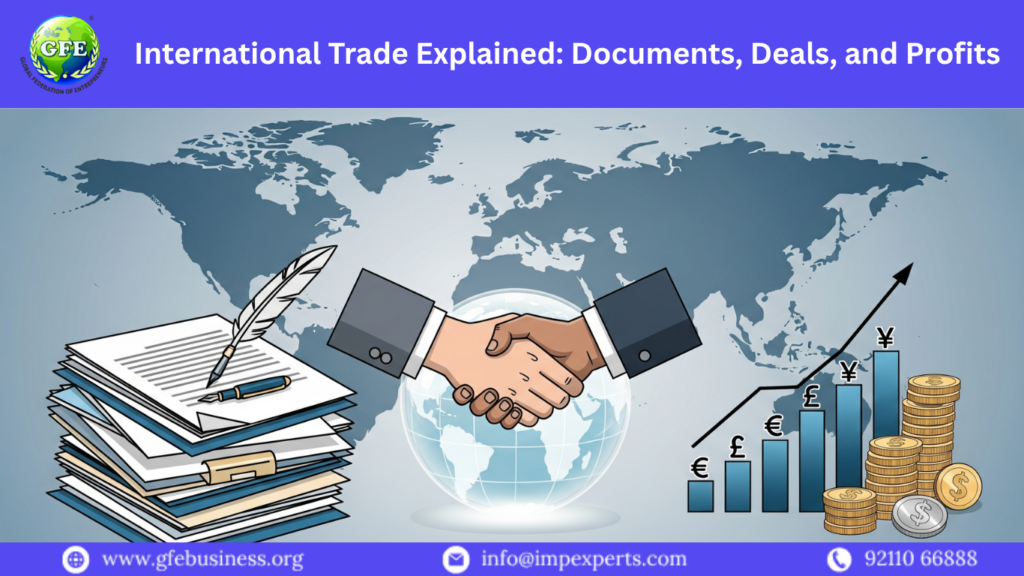Global trade has evolved from a government-dominated sector into one of the most accessible business models for individual entrepreneurs, students, traders, and professionals. In 2025, anyone with a clear product idea, internet access, and proper training can start participating in international trade from India.
At GFE Business, we help beginners transition from local trading to international exports through structured training, mentorship, and documentation support. Whether you want to become a merchant exporter or expand your current business globally, this blog will walk you through the essentials — from documents to deals to profits.
What is International Trade?
International trade is the exchange of goods and services across national borders. When India exports spices to the UAE or imports electronics from China, that’s international trade in action. It includes:
Exporting: Selling Indian goods to foreign buyers
Importing: Buying foreign goods for resale or manufacturing in India
Unlike local trading, international trade involves currency conversion, logistics coordination, documentation, and government compliance — but it also offers bigger markets and better profits.
Why International Trade is Growing in India
India’s production capabilities, cost advantages, and vast MSME network make it a strong player in international trade. Several government schemes such as RoDTEP, EPCG, and MEIS are available to exporters. Additionally:
Platforms like Alibaba, Tradewheel, and Global Sources allow exporters to find buyers worldwide
The Import Export Code (IEC) process is now 100% online and fast
Logistics and courier services are well-developed for both sea and air freight
E-commerce exports are now possible through Shopify, Amazon Global, and Flipkart Export Hub
International trade has moved from industrial parks to laptops and smartphones — and that’s where the opportunity lies for new exporters.
Key Documents in International Trade
Understanding documentation is one of the most important parts of succeeding in international trade. Every shipment must be supported with correct paperwork to ensure payment, customs clearance, and legal compliance.
Here are the essential documents you must learn:
Proforma Invoice
Sent before the deal is finalized. It includes product details, pricing, shipping terms, and payment instructions.Commercial Invoice
A finalized bill sent with the shipment. It is required by customs for both export and import countries.Packing List
Lists quantity, packaging method, dimensions, and weight of the goods.Bill of Lading / Airway Bill
The transport document issued by the shipping or courier company as proof of shipment.Certificate of Origin (COO)
Certifies the country of production, often required for government incentives or free trade agreements.FIRC (Foreign Inward Remittance Certificate)
Used as proof that payment was received in foreign currency.HS Code Declaration
The Harmonized System code identifies the product category for customs and taxation.
Without these documents, shipments may be delayed, rejected, or payments held up.
At GFE Business, we provide real samples, editable formats, and training on how to prepare each document correctly.
How International Deals Are Made
A common misconception is that international deals only happen through large expos or agents. In 2025, most export deals begin digitally.
Here’s how beginner exporters usually land their first order:
Identify a Focus Product
Choose a product with international demand and easy sourcing: jute bags, kitchen tools, garments, or agro-products.Create a Digital Product Catalog
A PDF or simple WhatsApp brochure with images, specifications, pricing, MOQ, payment terms, and delivery time.Reach Out to Buyers
Use B2B platforms, LinkedIn, Google search, and even Instagram to connect with procurement teams and importers.Negotiate Terms
Finalize price, quantity, Incoterms (FOB, CIF, etc.), and payment terms (advance, LC, or 50-50).Confirm via Proforma Invoice
Once the buyer agrees, send a proforma invoice with bank details, delivery time, and export documentation list.Proceed to Shipment
Ship the goods via air or sea based on order size and destination.
The key is consistency. Most exporters don’t succeed with the first message — but they do succeed by staying consistent and following a professional process.
Where the Profits Come From
Many people believe exports have slim margins. The truth is: when done right, international trade is significantly more profitable than local sales.
Here’s why:
Better Price Points: Foreign buyers often pay higher for quality goods from India
Lower Competition: Your product may be common locally, but rare and in demand in other countries
Volume Deals: B2B buyers usually place repeat orders in larger quantities
Currency Conversion Advantage: Profits earned in USD, EUR, or GBP convert into strong INR value
Let’s consider a quick example:
A jute bag sourced at ₹45 can sell internationally for ₹110–₹150
A ₹30 spice packet may sell for ₹90–₹120 overseas
An ₹80 handcrafted diya can retail for ₹300–₹500 in US e-commerce markets
Exporters also benefit from schemes like RoDTEP and SEIS, which add government incentives on top of profits.
How GFE Business Helps You Succeed in International Trade
Learning from scratch can be overwhelming, but GFE Business simplifies the process with:
Practical training programs for beginners
Assistance with IEC, AD code, and GST
Templates and walkthroughs for every export document
Support for product selection and pricing
Buyer-finding methods that work in 2025
Lifetime mentorship and real-time export guidance
We’ve helped entrepreneurs in Ahmedabad, Pune, Rajkot, Kolkata, Delhi, and Surat launch their first export shipments — even without business degrees.
Final Words
International trade is no longer reserved for large companies or MBA holders. With the right training, correct documentation, and a smart outreach strategy, you can build a profitable, sustainable export business directly from India.
Whether you’re just starting or want to scale beyond local limits, international trade is your next big opportunity.
Visit www.gfebusiness.org and connect with real trade opportunities. It’s time to take your business global.

